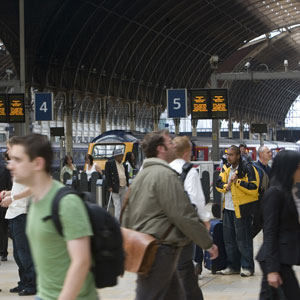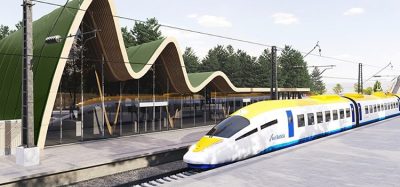Great Western passengers set to benefit from railway transformation
Posted: 1 March 2010 | | No comments yet
A high-level strategy predicts that millions of rail passengers will benefit from a major transformation on the railway in Great Western.
A high-level strategy predicts that millions of rail passengers will benefit from a major transformation on the railway in Great Western.
Millions of rail passengers are set to benefit from a major transformation on the railway in Great Western, according to a high-level strategy launched today by the rail industry.


Rail passengers at Paddington Station
The impact of the recommendations from this long-term strategy will benefit passengers from across the south west of england, Devon, Cornwall, the Thames Valley, Midlands and further into the north.
The Great Western RUS – published by Network Rail – confirms an industry consensus that there is a compelling case for the railway to grow further by the end of the decade, enhancing the benefits from the capacity-boosting electrification scheme and new trains.
By the end of the decade, rail demand is expected to be compounded with the introduction of electrification and a new fleet of trains. This will boost the number of passenger journeys (on long distance services into London Paddington) by 51% in 2019.
Bristol is predicted to experience the biggest growth of 41% in peak rail demand among key urban centres, burgeoning at a rate of 3.2% per year.
With the strategy, the Great Western will see more trains, better connectivity and shorter journey times, which aim to cater to demand in key growth areas.
The Great Western main line could also be among the most advanced in Britain with the implementation of one of the world’s most cutting-edge signalling technology on the route by the end of the decade. The European Rail Traffic Management System (ERTMS) is a new in-cab signalling system that helps to boost reliability and capacity.
Chris Rayner, route director, Network Rail, said: “Over the last decade, more and more people have been choosing to travel by rail on Great Western. Performance and reliability have risen dramatically, and so it is important that we continue investing in rail to expand the network with more seats, more services and better journeys”.
“It is vital that we take a long-term view so that the decisions we make now help develop a rail network that is fit for the future. I thank those who made a valuable contribution in the formation of this strategy as part of the consultation process. This will provide an important input to our planning.”
The 30-year strategy will be put forward to the Department for Transport to help inform the planning for the industry’s next funding period from 2014 to 2019.
Recommended options that require funding from either government or third parties or require further review include:
Capacity, performance and connectivity
- Infrastructure enhancements around Bristol Temple Meads to remove performance bottlenecks and to boost capacity including:
- Extension of the existing carriage line from Bristol Temple Meads to Parson Street to create a four track section for passenger trains
- Development of three or four tracks between Dr Days Junction and Filton Abbey Wood
- Additional signals between Kemble and Standish Junction as part of the Swindon – Kemble redoubling scheme to increase capacity on the route.
- An additional platform at Westbury station to improve performance and capacity
- Five additional vehicles for Cardiff to Portsmouth services to provide more seats to passengers from Filton Abbey Wood, Bristol Temple Meads, Bath Spa, Trowbridge, Bradford-on-Avon, Westbury, Warminster and Salisbury
- Three additional vehicles for Cardiff to Taunton services to provide more seats to passengers from Patchway, Filton Abbey Wood, Bristol Temple Meads, Nailsea and Backwell, Yatton, Worle, Weston-super-Mare, Highbridge and Burnham and Bridgwater
- An additional vehicle for Gloucester to Westbury services to provide more seats to passengers from Cam & Dursley, Yate, Bristol Parkway, Filton Abbey Wood, Bristol Temple Meads, Keynsham, Oldfield Park, Bath Spa, Freshford, Trowbridge, Avoncliff and Bradford-on-Avon
- An enhanced cross-Bristol service, requiring additional trains, will improve connectivity and provide extra capacity through an:
- Additional hourly service between Bristol Temple Meads and Yate (subject to third-party funding);
- Additional hourly service between Bristol Temple Meads and Bath Spa (subject to performance modelling) with the potential of extending the service to Clifton Down or Avonmouth
- Additional hourly service between Westbury and Chippenham or Swindon, subject to local demand assessments and operational viability.
- An extension of the existing Newcastle to Reading service to Southampton on a two-hourly basis to improve connectivity from the North East to the South Coast (subject to performance modelling of the Basingstoke station area).
- Four additional vehicles to improve capacity on the Reading to Gatwick Airport service for two morning and two evening peak services.
- Between eight and 19 additional vehicles for interurban services to ease overcrowding on the Edinburgh to Plymouth, Manchester to Bournemouth and Manchester to Bristol Temple Meads/Paignton corridors.
- An additional hourly Paignton to St James Park service from 2016 for cross-Exeter services, improving connectivity and boosting capacity.
Journey times
- Revised calling patterns of one morning and evening peak Cardiff to Portsmouth service to reduce journey times by up to nine minutes
- Increased linespeed between Bristol Temple Meads and Bridgwater
- Increased linespeed between Gloucester and Severn Tunnel Junction. The improvement will provide a robust alternative route and improve the reliability of rail services travelling via Gloucestershire.
These recommendations will bring incremental benefits by building on the following major schemes, which have been approved and committed by the government over the next five to ten years.
- Reading railway re-modelling scheme – The scheme is designed to ease the bottleneck on the railway in the Reading area and vital to deliver a 37% improvement to performance reliability to the area and across the route. This scheme will benefit the many destinations that Reading serves, including London Paddington, Oxford, Bristol, South Wales, Devon and Cornwall, along with the North, London Waterloo, Gatwick Airport and the South Coast.
- Electrification – Led by Network Rail, the scheme aims to improve the capability of the infrastructure of Great Western main line by powering trains with electricity. The scheme is currently at the early development stage and is expected to be delivered from 2016 to coincide with the launch of the new fleet of trains.
- European Railway Traffic Management System (ERTMS) – The national programme aims to completely modernise the signalling infrastructure on the Great Western main line with in-cab signalling technology, enhancing operations and improving capacity. It is expected to be delivered on the Great Western main line from 2016 onwards.
The final Great Western RUS document can be downloaded from www.networkrail.co.uk






